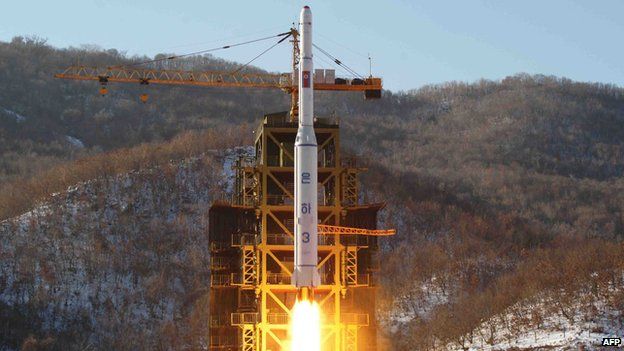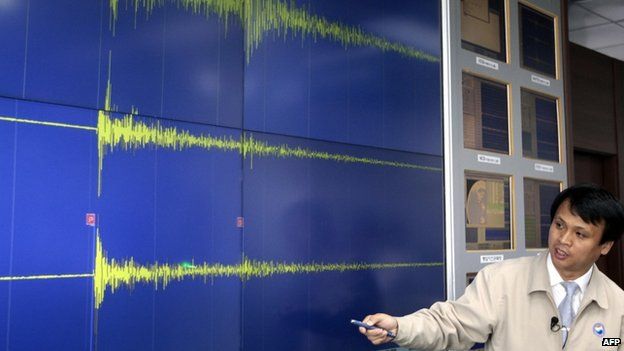North Korea's nuclear programme remains a source of deep concern for the international community. The BBC looks at North Korea's nuclear ambitions and multinational efforts to curtail them despite three nuclear tests.

Has North Korea got the bomb?
 AFP
AFP
Technically yes, but not yet the means to deliver it via a missile.
In 2006, 2009 and again in 2013, North Korea announced that it had conducted successful nuclear tests - they all came after the North was sanctioned by the UN for launching rockets.
Analysts believe the first two tests used plutonium as the fissile material. The North is believed to possess enough weapons-grade plutonium for at least six bombs. Whether it used plutonium or uranium for the 2013 test is unclear.

What do we know about the North's nuclear programme?
 AFP
AFP
The Yongbyon site is thought to be its main nuclear facility. The North has pledged several times to halt operations there and even destroyed the cooling tower in 2008 as part of a disarmament-for-aid deal.
But in March 2013, after a war of words with the US and with new UN sanctions over the North's third nuclear test, it vowed to restart all facilities at Yongbyon.
However, the US never believed Pyongyang was fully disclosing all of its nuclear facilities - a suspicion bolstered when North Korea unveiled a uranium enrichment facility at Yongbyon (purportedly for electricity generation) to US scientist Siegfried Hecker in 2010.
Mr Hecker's 2010 visit and subsequent report remains the most recent and reliable account of the complex.
In April 2015 a US think tank said satellite pictures taken in early 2015 suggested the reactor at Yongbyon may have been restarted.
Then in September, state media announced that "normal operation" had started at the production plant.
 Reuters
Reuters
Both the US and South Korea have also said that they believed the North had additional sites linked to a uranium-enrichment programme.
A test based on a uranium device would spell new dangers for monitoring and proliferation because weapons-grade plutonium enrichment happens in large facilities that are easier to spot.
Uranium enrichment uses many, possibly small, centrifuges that can be hidden away. While North Korea has depleted its stocks of "reactor-grade" plutonium needed to make the weapons-grade variety, the country has plentiful reserves of uranium ore.
North Korea's nuclear programme remains a source of deep concern for the international community. The BBC looks at North Korea's nuclear ambitions and multinational efforts to curtail them despite three nuclear tests.

Has North Korea got the bomb?
 AFP
AFP
Technically yes, but not yet the means to deliver it via a missile.
In 2006, 2009 and again in 2013, North Korea announced that it had conducted successful nuclear tests - they all came after the North was sanctioned by the UN for launching rockets.
Analysts believe the first two tests used plutonium as the fissile material. The North is believed to possess enough weapons-grade plutonium for at least six bombs. Whether it used plutonium or uranium for the 2013 test is unclear.

What do we know about the North's nuclear programme?
 AFP
AFP
The Yongbyon site is thought to be its main nuclear facility. The North has pledged several times to halt operations there and even destroyed the cooling tower in 2008 as part of a disarmament-for-aid deal.
But in March 2013, after a war of words with the US and with new UN sanctions over the North's third nuclear test, it vowed to restart all facilities at Yongbyon.
However, the US never believed Pyongyang was fully disclosing all of its nuclear facilities - a suspicion bolstered when North Korea unveiled a uranium enrichment facility at Yongbyon (purportedly for electricity generation) to US scientist Siegfried Hecker in 2010.
Mr Hecker's 2010 visit and subsequent report remains the most recent and reliable account of the complex.
In April 2015 a US think tank said satellite pictures taken in early 2015 suggested the reactor at Yongbyon may have been restarted.
Then in September, state media announced that "normal operation" had started at the production plant.
 Reuters
Reuters
Both the US and South Korea have also said that they believed the North had additional sites linked to a uranium-enrichment programme.
A test based on a uranium device would spell new dangers for monitoring and proliferation because weapons-grade plutonium enrichment happens in large facilities that are easier to spot.
Uranium enrichment uses many, possibly small, centrifuges that can be hidden away. While North Korea has depleted its stocks of "reactor-grade" plutonium needed to make the weapons-grade variety, the country has plentiful reserves of uranium ore. North Korea's nuclear programme remains a source of deep concern for the international community. The BBC looks at North Korea's nuclear ambitions and multinational efforts to curtail them despite three nuclear tests.

Has North Korea got the bomb?
 AFP
AFP
Technically yes, but not yet the means to deliver it via a missile.
In 2006, 2009 and again in 2013, North Korea announced that it had conducted successful nuclear tests - they all came after the North was sanctioned by the UN for launching rockets.
Analysts believe the first two tests used plutonium as the fissile material. The North is believed to possess enough weapons-grade plutonium for at least six bombs. Whether it used plutonium or uranium for the 2013 test is unclear.

What do we know about the North's nuclear programme?
 AFP
AFP
The Yongbyon site is thought to be its main nuclear facility. The North has pledged several times to halt operations there and even destroyed the cooling tower in 2008 as part of a disarmament-for-aid deal.
But in March 2013, after a war of words with the US and with new UN sanctions over the North's third nuclear test, it vowed to restart all facilities at Yongbyon.
However, the US never believed Pyongyang was fully disclosing all of its nuclear facilities - a suspicion bolstered when North Korea unveiled a uranium enrichment facility at Yongbyon (purportedly for electricity generation) to US scientist Siegfried Hecker in 2010.
Mr Hecker's 2010 visit and subsequent report remains the most recent and reliable account of the complex.
In April 2015 a US think tank said satellite pictures taken in early 2015 suggested the reactor at Yongbyon may have been restarted.
Then in September, state media announced that "normal operation" had started at the production plant.
 Reuters
Reuters
Both the US and South Korea have also said that they believed the North had additional sites linked to a uranium-enrichment programme.
A test based on a uranium device would spell new dangers for monitoring and proliferation because weapons-grade plutonium enrichment happens in large facilities that are easier to spot.
Uranium enrichment uses many, possibly small, centrifuges that can be hidden away. While North Korea has depleted its stocks of "reactor-grade" plutonium needed to make the weapons-grade variety, the country has plentiful reserves of uranium ore.
No comments:
Post a Comment